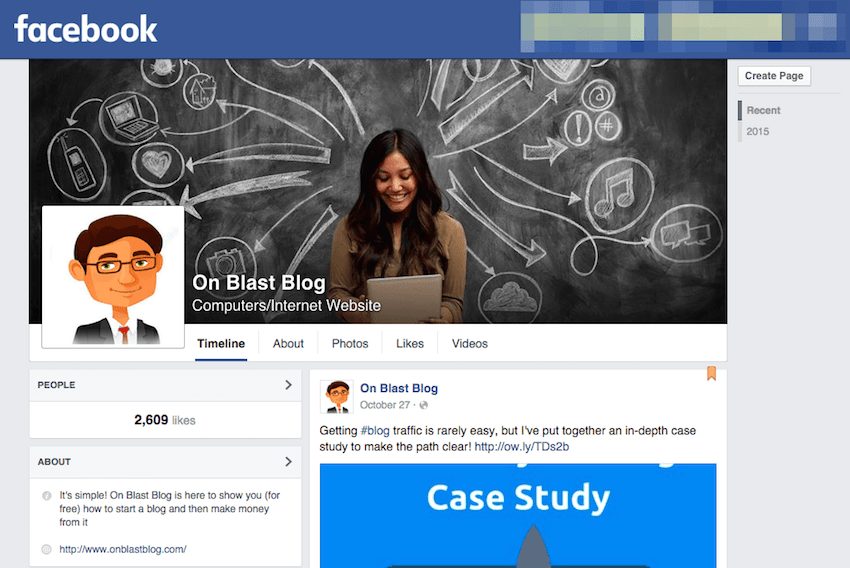My first encounter with social media was a long time ago. My first account wasn’t on Facebook or Twitter…it was on Myspace, and this was long before it became a music platform.
When Facebook first showed up on the scene I laughed.
This site will never take off, I thought.
Well, as you can plainly see, my past self was entirely wrong. The world of social media has grown far beyond a simple internet hangout. Today websites like Facebook, Twitter, and plenty of others are becoming CRUCIAL for success as a blogger. They offer a rich potential to connect with, engage, and attract new readers and leads to your site.
This trend isn’t going anywhere in 2020, 2021, or anytime in the foreseeable future. So today I’m going to give you the complete rundown on how to rock the social media world in the coming year.
To skip past the Infographic and read about the five social media platforms, click here
Become a Social Media Rock Star in 2020
Strut your confidence on the most popular social networks with this infographic on how to be a social media rock star [2016 edition].
In this article you’ll find:
- An image sizing cheat sheet for every social platform so you’ll have a handy guide when selecting the best image sizes & type for each social network.
- Keyboard shortcuts to save you precious time in connecting with your community.
- The best days to post for each social network so you’ll know with confidence your last post will engage the most people.
- Social Media tools you have to be using every day.
- Tips & tricks on how to generate more shares and engagement, broken down by social network.
- Finally, a proven blueprint on how to write the most irresistible headlines so you can keep your readers thirsty for more.

Meet and Greet: An Overview of The 5 Largest Social Media Platforms
Today we’ll be covering five of the internet’s most popular and widespread platforms. Let’s take a look at the contestants:
1. Facebook
Launched on February 4, 2004, by Mark Zuckerberg, Facebook is one of, it not the most, recognizable social networking platform in the world. With over 1.4 billion users around the world, just about everyone you’ve ever known, or will ever know has a profile on this platform.
These Facebook Statistics will blow your mind:
- People share 1.3 million pieces of content every minute
- 350 million photos are uploaded each day
- Facebook adds 8 new users per second, or 7,246 people every 15 minutes
2. Twitter
What started as a microblogging site has now become one of the largest social media platforms. It all started back in March of 2006.
Since then, the site has garnered some impressive numbers:
- 300 billion tweets have been sent since the site’s beginning
- The average number of followers is 208
- Tweets including images have 5 times the engagement
3. Pinterest
When Pinterest first hit the scene, it was entering a world dominated by text, not images. Despite being the underdog, it became the third-largest network in the U.S. within two short years! Today it is a marketing gold mine.
Check out these Pinterest statistics:
- Despite the thinking that most Pinterest users are women, 33.3% of all sign-ups are actually men.
- 75% of time spent on Pinterest is done with a mobile device
- There are over 100 million active users
4. YouTube
YouTube began as an idea drummed up by three PayPal employees who wanted a website where they could upload, share, and watch videos. The domain became active in 2005. It’s incredible how far the site has come since then.
These YouTube numbers are mind-blowing:
- There are over one billion users on the site.
- 80% of YouTube’s traffic comes from outside the U.S.
- YouTube has paid over $1 billion to partners in revenue
5. Instagram
What started as an iOS exclusive app has since become a mobile and internet icon for sharing images.
It’s a relatively young platform with roots dating back to 2010, but it’s already built up some serious statistics:
- There are 400 million active users per month
- 51% of users are male, 49% are female
- 75% of Instagram users are outside the U.S.
Marketing and Promoting Your Content on Social Media
Here we’ll cover all the aspects of these platforms and how to use them for all of your marketing and content promotion needs.
These platforms started their lives as social networks, but today they hold huge potential for marketing your content and promoting it to readers both new and old.
7 Best Practices for Marketing on Social Media Platforms
Ultimately, the goal on everyone’s mind right now is to make money blogging, right? Making that dream a reality absolutely requires that you learn a thing or two about social media marketing.
This is where you’ll find your audience and connect with them. Your efforts here will bring people both new and familiar back to your site to read your content, follow your call-to-action, and ultimately convert into customers for your brand.
When planning your marketing efforts on any social network, remember these best practices:
Social Media Marketing Best Practices
- Plan Ahead – Don’t go into this blind, make sure you perform keyword research and get to know your audience. This way, you can make sure you’re showing them things they’re interested in.
- Offer Value and Quality – High-quality content is always a major focus, and it’s no different here. Focus on promoting content that is interesting and valuable to your audience
- Maintain Your Brand’s Image – Ensure that your brand’s image is consistent on every platform. Use the same voice, language, and identity regardless of which site you’re using.
- Start a blog – It goes without saying, but you’ll need something to promote if you’re going to be on social media. Whether you’re an individual or a large business, creating a blog gives you a place to develop and content you’ll be promoting on your profiles.
- Link to Other Sites – Your primary focus should be sharing and promoting your content, but don’t hesitate to mix that with relevant and interesting content from other sites. Linking to other sources can earn you links of your own and improves your credibility.
- Keep an Eye on the Competition – Always keep your eyes on the competitors in your social sphere. If you see them doing something that works, adopt that same strategy and make it your own for improved results.
- Measure Your Success – Since many social media efforts will require some level of investment, you should track the effects of your marketing by utilizing an analytic tool like Google Analytics, which will show how your website’s traffic, bounce rate, and other factors are changing.
Marketing Strategies For Each Platform
Now that you have a strong idea of how to plan and implement your marketing strategy, let’s take a look at how each platform offers a unique approach and options for your campaign.

Status Update: Marketing on Facebook
While Facebook has certainly opened up as a marketing tool, it still has roots in being a social hangout and a place for people to relax and browse the daily lives of their friends and family.
To this end, you should start by making a Facebook Business Fan Page. This page will act as a profile for your brand and a place to post all of your latest content. It will also be a great place to interact with and engage members of your audience.

You can also set up a group on Facebook, which like making a page, is completely free. Groups act as a discussion forum where you can attract and engage all kinds of people from your audience.
Finally, Facebook also offers advertisement options. These have incredible customization options that allow you to target specific geographical areas, education levels, ages, and even the types of devices they’re using.
#RockStar: Twitter’s Marketing Options
Twitter is an amazing and simple platform that limits posts to 160 characters or less. This limit means that you’ll need to say more with less. One of the best strategies here is to intrigue and entice potential readers with tweets that pose a question, offer a statistic, or identify an issue.
Twitter organizes and categorizes tweets using hashtags. Always include a relevant tag with your tweets so it gets seen by the right people. Asking your followers to favorite and retweet (RT) will also help spread your influence.
Marketing options on Twitter include prmoted:
- Tweets
- Accounts
- Trends
Starting with the first option, promoted tweets are paid tweets that can be displayed at the top of certain people’s feeds. Tweets flow like a rushing river down a person’s feed, so this option allows you to keep one of your own at the top.
You’ll be able to promote tweets to specific locations, followers, and certain keywords in search results. Secondly, there’s an option for promoted accounts which makes your account appear in the “Who to Follow” section on the left side of the user’s Twitter feeds. This is used to gain more influencers as followers of your brand.
Finally, there are promoted trends. These are specific hashtags that will appear on the left side of the user’s feeds. By investing in a promoted trend, your topic of choice can appear as “trending” in this section.
Pin This Now: Marketing Options on Pinterest
Pinterest may be young, but it’s an up-and-comer for sure. This image-focused platform offers a wholly unique way to promote your content. On the surface, the site is essentially a massive pinboard where people can post images and comment on them.
Each time an image is pinned, it creates a link back to your website. When someone repins your images, that’s another link back to your blog. When creating your Pinterest profile, include a profile picture and make sure that it isn’t hidden from search engines in the settings. This way it will be indexed by Google and show up on search results.
Adding the Pinterest share button to images on your site is also a great way to connect the visual aspects of your site to your Pinterest profile. From here, create boards with unique titles and descriptive names. Upload only high-quality images and give them specific titles and descriptions so they get noticed.
Beyond this, you can also take advantage of Promoted Pins. This new feature allows you to choose pins that you want to show members of your audience. Once you set up your targeting preferences, you can choose to pay for engagement or visits to your blog and track the entire effort in the process.
You Me? YouTube: Marketing Options
Video content is on the rise as YouTube continues to break records and shatter expectations. It’s replacing television and cable at a rapid rate, so now is the time to start understanding and utilizing the marketing potential here.
There are four kinds of YouTube Advertising Options:
Advertising on YouTube
- In-Stream – These are ads that play before or during a video. After 5 seconds the user can skip, but you will only pay if they watch more than 30 seconds.
- In-Slate – Ads that show at the beginning of a video that is ten minutes or longer. These allow you to choose between three different adverts or as one ad. You only pay if the user watches the video.
- In-Search – These are a lot like Google Adwords advertising in the sense that they appear when certain keywords are searched on YouTube. They are placed on the top and right-hand side of the results.
- In-Display – This type is different because it appears beside YouTube videos that are embedded on other sites as part of Google’s Display Network.
You can choose who sees your ads based on a variety of options like demographics, interests, keywords, topics, device type, and more. All four options on YouTube offer a lot of potential. The biggest focus you should have is on reaching the right people by understanding your audience.
InstaSuccess: Marketing on Instagram
Instagram is a lot like Pinterest, but it offers a lot more in terms of customization. When using this platform for your brand and blog, try adding some new tactics and strategies to your overall approach. These will help you get more engagement and better returns on your investment.
Beyond simply posting images, try using a free tool like Canva to create graphics that add text and ultimately tie the image back to your brand. You can also do this by telling a story inside your captions.
Instagram also offers advertisements now that appear as sponsored images. Since Facebook purchased the platform for a cool $1 billion, you can manage your Instagram ads on your Facebook profile which makes it easy to cover both sites.
Final Thoughts
Social media is a constantly evolving and ever-growing tool for marketing promoting your blog’s content. Between this information and the included infographic, I’m more than confident that you’ll be a rock star on these websites in 2016.
Thanks as always for reading and be sure to share your own tips in the comments below!





